Eristalis transversa
Eristalis transversa, the transverse banded drone fly, is a common species of syrphid fly first officially described by Wiedemann in 1830.[1] Hoverflies get their names from the ability to remain nearly motionless while in flight. The adults are also known as flower flies for they are commonly found around and on flowers, from which they get both energy-giving nectar and protein-rich pollen. The larvae are rat-tailed type but larvae of this specific species has not been reported.[3][2][4][5]
| Eristalis transversa | |
|---|---|
_-_MacGregor_Point_Provincial_Park_01.jpg.webp) | |
| Male | |
 | |
| Female | |
| Scientific classification | |
| Domain: | Eukaryota |
| Kingdom: | Animalia |
| Phylum: | Arthropoda |
| Class: | Insecta |
| Order: | Diptera |
| Family: | Syrphidae |
| Genus: | Eristalis |
| Species: | E. transversa |
| Binomial name | |
| Eristalis transversa | |
| Synonyms[2] | |
Distribution
external map Species reported from North America east of the Mississippi River and into Southeastern Canada.
Description
For terms see Morphology of Diptera. external images
- Size
- 7–12 mm (0.28–0.47 in)
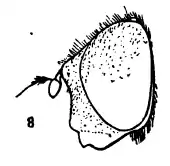
- Head
- The eyes are pilose on upper half and broadly contiguous in the male. The front is black, shining in the middle, black pile on the sides. The female also with black pile, narrowed above but on the lower two-thirds reddish pollinose. The antennae are reddish yellow. The basal portion of arista sparsely plumose. The sides of the face covered with dense whitish pollen and whitish pile, the median stripe (tubercle) and cheeks are shining black.
- Thorax
The notum is opaque black, with three grayish olive transverse bands. The pleurae covered with thick yellow pile. The scutellum is bright yellow, with narrow black along its base.
- Abdomen
The first segment black; second segment with large yellow lateral triangles (smaller in the female), and narrow posterior yellow ring, against a black background that extending narrowly to the lateral margins; third segment with large spots on the sides in front connected by a yellow ring against a black background a yellow ring borders the rear of the segment. The female has only a posterior yellow ring on a black background. Fourth segment with a small yellow spot on the front quarters, and a posterior yellow ring, remainder of the segment opaque black with an entire shining cross-band before the middle of the segment. The female has only a posterior yellow ring on a black background. Hypopygium shining black.
- Wings
The wings are hyaline. The basal portion a little yellowish. Noteworthy veination - Spurious vein (sv), looping of R4+5 into r4+5, closed cell r2+3.anterior cross- vein (r-m) near the middle of discal cell (dm), oblique.
- Legs
The legs are variably coloured usually black with the tip of femora and base of tibiae yellow. Sometimes the distal half of all the femora and the base of bind tibiae, femora, and the larger portion of the tarsi are yellow or more rarely the front and middle legs may be almost wholly yellow and the black confined to outer part of bind femora. The tip of the hind tibiae, and tip of all the tarsi?? [6][7]
_wing_veins.svg.png.webp) Eristalis wing
Eristalis wing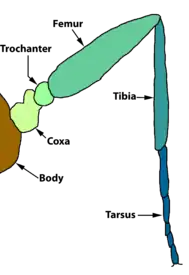 Insect leg
Insect leg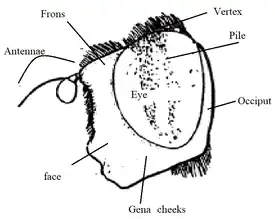 Eritalis head
Eritalis head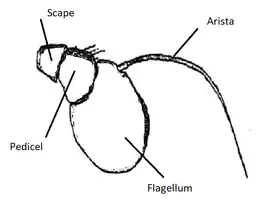 Antenna syrphid
Antenna syrphid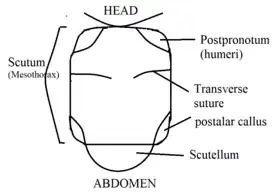 dorsal view of Syrphid thorax
dorsal view of Syrphid thorax
References
- Wiedemann, Christian Rudolph Wilhelm (1830). Aussereuropäische Zweiflügelige Insekten. Vol. 2. Retrieved 21 April 2020.
- "Eristalis transversa Report". Integrated Taxonomic Information System. Retrieved 2019-09-23.
- Skevington, Jeffrey H (2019). Field Guide to the Flower Flies of Northeastern North America. ISBN 9780691189406.
- "Eristalis transversa". GBIF. Retrieved 2019-09-23.
- "Eristalis transversa species Information". BugGuide.net. Retrieved 2019-09-23.
- Hull, Frank Montgomery (1925). "A Review of the Genus Eristalis Latreille in North America". The Ohio Journal of Science. 25: 11–45. hdl:1811/2257.
 This article incorporates text from this source, which is in the public domain.
This article incorporates text from this source, which is in the public domain. - Williston, S.W. (1887). "Synopsis of the North American Syrphidae". Bulletin of the United States National Museum. 31: 1–335.
Further reading
- Telford, H. S. (1970). "Eristalis (Diptera: Syrphidae) from America North of Mexico". Annals of the Entomological Society of America. 63 (5): 1201–1210. doi:10.1093/aesa/63.5.1201.